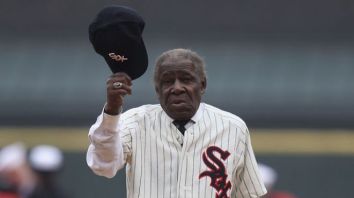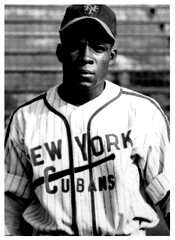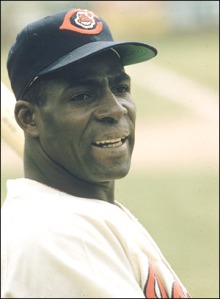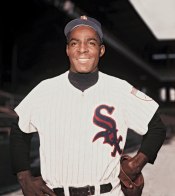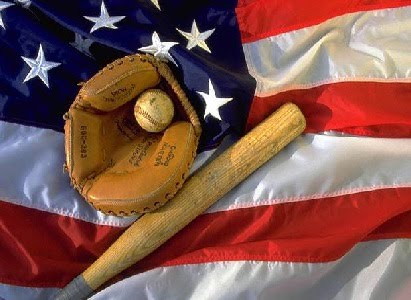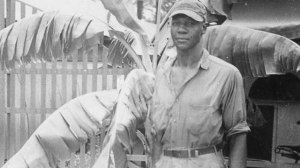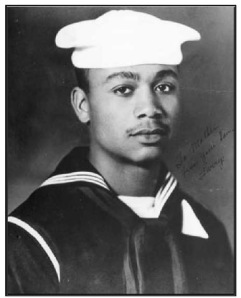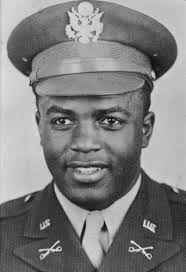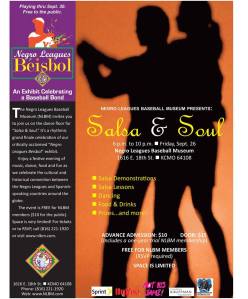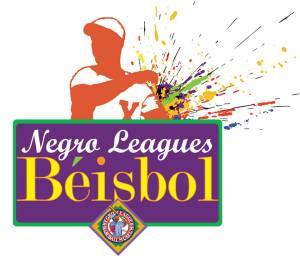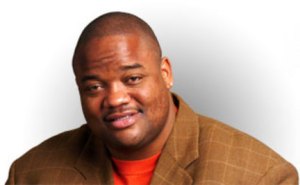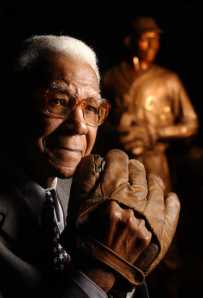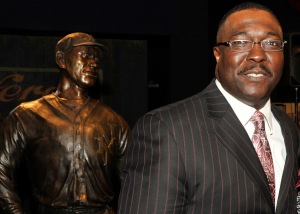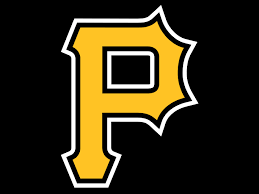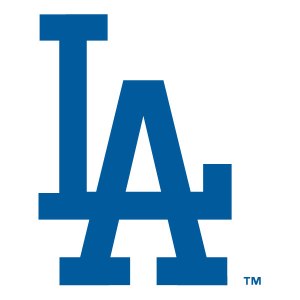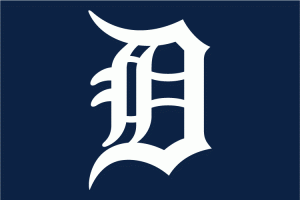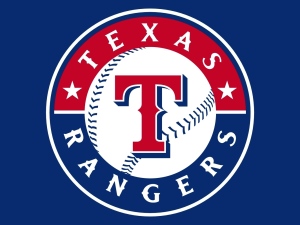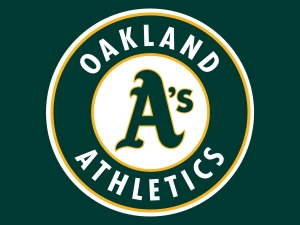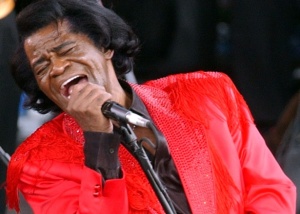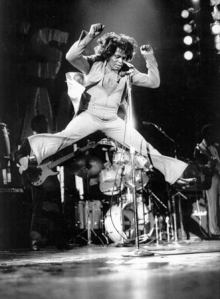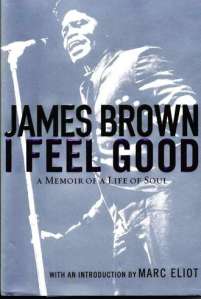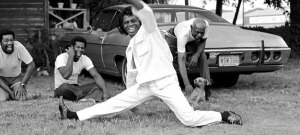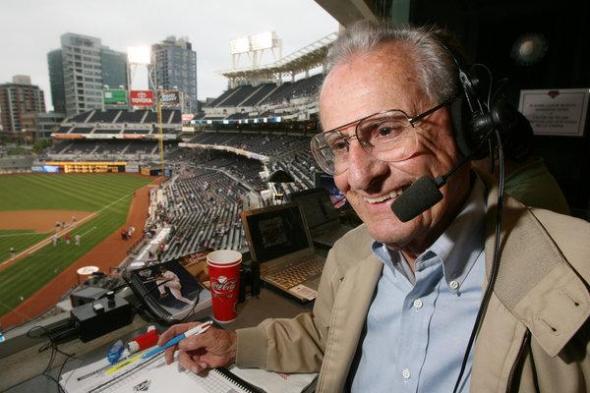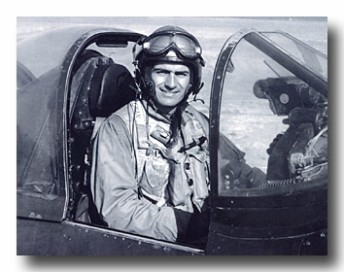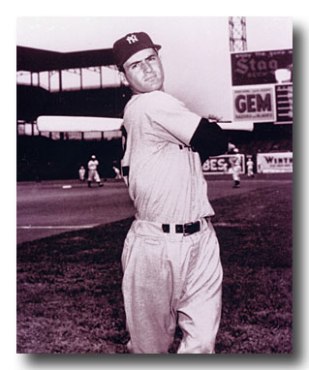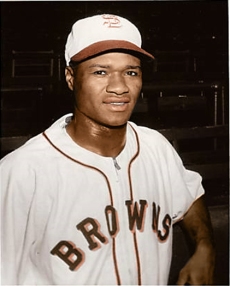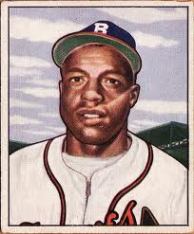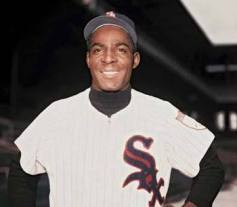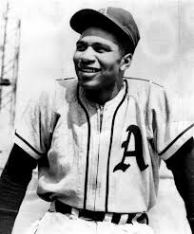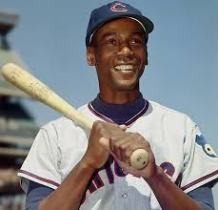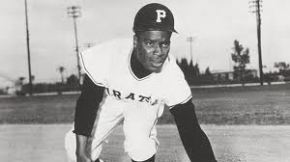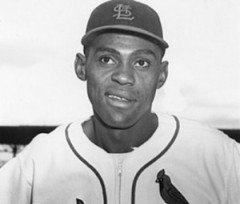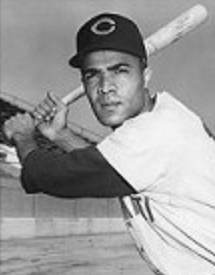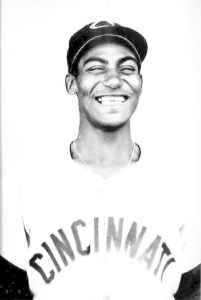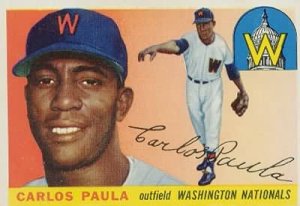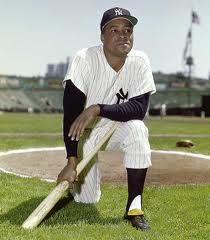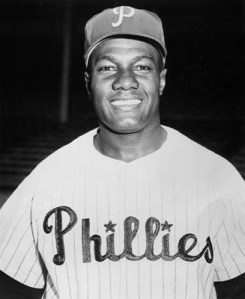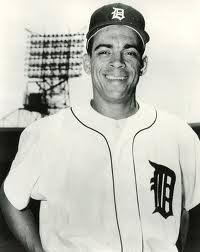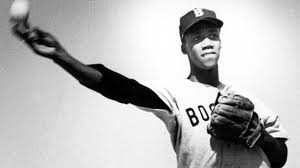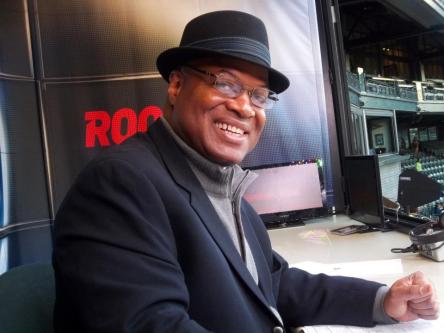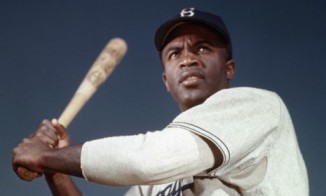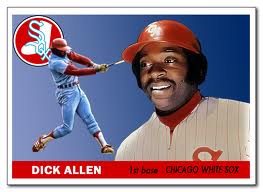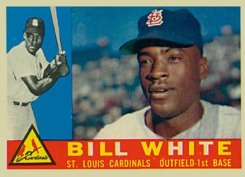Tagged: Negro Leagues
The Minnie Minoso Effect
So much was made – and rightly so this past season about the impact of young, exciting players from Cuba.
Today, on his birthday – we celebrate the man who opened the door for players like Yasil Puig and Jose Abreu – Minnie Minoso.
Born Saturnino Orestes Armas Miñoso Arrieta in Perico, Cuba – the Cuban Comet began his professional baseball career in the Negro Leagues appropriately with the New York Cubans where he quickly became an All Star at third base. In his first year for the Cubans, Minoso hit .309 and followed that up in 1946 helping New York win the Negro National League pennant and capture the World Series from the Negro American League’s Cleveland Buckeyes.
Minoso’s Negro Leagues career lasted only three seasons (he was an All Star in 1947 and 1948) as in 1949 he made the move to the Major Leagues as the color barrier was slowly falling and joined Larry Doby on the Cleveland Indians roster.
Every move to the big leagues from the Negro leagues is historic even after Jackie Robinson signed with the Dodgers. Minoso’s move was not only historic because of the color of his skin but also because he became the first Black Cuban player to play Major League Baseball. Later in 1951, Minnie was traded to the Chicago White Sox becoming their first player of color. He “quickly” led the Sox in stolen bases his first three seasons.
Between his Negro Leagues, Major and Minor League baseball career and an almost decade long time in Mexico, Minoso played in five different decades making his last appearance for the Pal Hose in 1980. Thew only player in baseball history to do so. Chicago retired his #9 in 1983.
Inexplicably, Minoso is not in the Hall of Fame after a career that saw him make nine All Star games, win three Gold Gloves and hit .298 during a career which saw crowds chant Go! Go! when he wheeled around the bases.
Minoso like Robinson, will be most remembered as a player who brought a new never before seen form of entertaining baseball to stadiums across the country and someone who influences the game even today by opening the door to the baseball crazed country of Cuba.
Happy birthday Minnie!
Dave Barr (@daveabarr)
Negro Leagues Players Played Major Role In World War II
There are many well known stories of Major League Baseball players who served their country valiantly. From Bob Feller to Yogi Berra, dozens of baseball players who now are enshrined in Cooperstown fought in World War I, World War II and the Korean War – 64 to be exact.
Of that heroic list – Leon Day, Jackie Robinson, Buck O’Neil , Larry Doby and Monte Irvin all fought in the Second World War while Ernie Banks and Willie Mays fought in the Korean Conflict.
Below is a list of Negro Leagues players who fought for a country that had yet to begin to fight for them in World War II. From the Army Air Corp to the Army, Navy and Marines – 119 players Negro League baseball players put their lives on the line and baseball careers on hold when their country asked for their ultimate commitment.
While wartime and baseball are forever linked because of the great players who fought and the break from the sadness and death of war that it provided. Today we remember those who served their country and those who paid the ultimate price. We should forget about balls and strikes and pay homage to the bravery and courage that each of these and thousands of others displayed.
Special thanks to one of my favorite baseball websites Baseball In Wartime for the help with all of the names on this list.
| Name | Position | Team | Service | Location | Years | Details |
| Russell Awkard | OF | Newark Eagles | Army | ETO | 1941-1945 | Quartermaster Corps in England, France and Belgium. |
| John “Red” Bailey | Toledo Crawfords | Army | USA | 1942- | Fort Bragg | |
| Dan Bankhead | P | Birmingham Black Barons | Marines | 1943-1945 | ||
| Richard A “Skeeter” Banks | Richmond Giants | Army | MTO | 1941-1945 | Trucking company in N Africa, Sicily and Italy | |
| Lamb “Bud” Barbee | 1B | Baltimore Elite Giants | Army | 1943-1945 | ||
| Sam Barber | P | Cleveland Buckeyes | Army | 1942-1945 | ||
| Bill Barnes | P | Baltimore Elite Giants | Army | 1944-1945 | ||
| Jeremiah Bennett | Philadelphia Stars | Army | Pacific | 1942-1945 | ||
| Charlie Biot | OF | Baltimore Elite Giants | Army | Pacific | 1942- | Captain of 93rd Division baseball team. (369th Infantry Regt) |
| Joe Black | P | Baltimore Elite Giants | Army | 1943- | ||
| Garnett Blair | P | Homestead Grays | Army | 1942-1945 | ||
| William “Bill” Blair | P | Cincinnati Clowns | Army | Youngest African-American to serve as first sergeant | ||
| Jim Bolden | P | Cleveland Buckeyes | Army | 1942-1946 | ||
| Lyman Bostock, Sr | 1B | Birmingham Black Barons | Army | 1942-1945 | ||
| Herb Bracken | P | Cleveland Buckeyes | Navy | Pacific | 1944-1945 | Was 13-1 at Great Lakes and served in Hawaii. |
| Sherwood Brewer | 2B | Kansas City Monarchs | Army | Pacific | 1943- | Discovered playing baseball in Guam. Also served in Korea. |
| Barney Brown | P | Philadelphia Stars | Army | 1943 | ||
| James Brown | P | Newark Eagles | Army | ETO | 1944-1945 | |
| Willard “Home Run” Brown | OF | Kansas City Monarchs | Army | ETO | 1944-1945 | Played for ETO champion OISE All-Stars in 1945. |
| Allen “Lefty” Bryant | P | Kansas City Monarchs | Army | 1941-1945 | Sergeant. | |
| Chester Buchanan | P | Philadelphia Stars | Navy | 1944-1945 | ||
| Ernest Burke | P | Baltimore Elite Giants | USMC | Pacific | ||
| Matthew “Lick” Carlisle | 2B | Homestead Grays | Navy | 1945 | ||
| Elmer Carter | Kansas City Monarchs | Army | ETO/MTO | 1942-1945 | In N Africa and Normandy | |
| Marlin Carter | 3B | Memphis Red Sox | Coast Guard | Pacific | 1943-1945 | Saw Hiroshima and Nagasaki. |
| James “Bus” Clarkson | SS | Philadelphia Stars | Army | Pacific | 1943-1945 | Camp Clarkson, CA and New Caledonia with field artillery unit |
| Jim Cohen | P | Indianapolis Clowns | Army | USA | 1942-1946 | Camp Lee, Virginia. |
| Jim Colzie | P | Indianapolis Clowns | USAAF | USA | 1943-1945 | Orlando AAB, Florida |
| Bill Cooper | C | Philadelphia Stars | Army | 1943-1945 | ||
| Jimmie Crutchfield | OF | Chicago American Giants | Army | 1943-1945 | ||
| Ross “Satchel” Davis | P | Cleveland Buckeyes | Army | 1944-1945 | ||
| Spencer Davis | OF | New York Black Yankees | Army | 1944-1945 | ||
| Leon Day | P | Newark Eagles | Army | ETO | 1944-1945 | At Utah Beach on D-Day with 818th Amphibian Battalion. Played for ETO champion OISE All-Stars in 1945. |
| Larry Doby | SS | Newark Eagles | Navy | 1944-1945 | Was at Ulithi. | |
| Mahlon Duckett | INF | Philadelphia Stars | Army | 1944-1945 | ||
| Frank Duncan, Jr | C/MGR | Kansas City Monarchs | Army | ETO | 1942-1943 | Drafted in 1942/43 aged 42. Sergeant with 371st Infantry, 92nd Division. |
| Frank Duncan III | P | Kansas City Monarchs | Army | 1942-1943 | ||
| Jake Dunn | SS | Philadelphia Stars | Army | 1942-1945 | One of the first Negro Leaguers to enter military service. | |
| Howard Easterling | 3B | Homestead Grays | Army | 1944-1945 | ||
| Jim Elam | P | Newark Eagles | Army | 1944-1945 | ||
| Wilmer “Red” Fields | P | Homestead Grays | Army | 1943-1946 | ||
| Joe Fillmore | P | Philadelphia Stars | Army | 1943-1946 | ||
| Jake Flowers | IF | Army | ETO | 1944 | Corporal | |
| Jonas Gaines | P | Baltimore Elite Giants | Army | USA | 1943-1945 | Fort Lewis |
| Jerry Gibson | OF-P | Homestead Grays | Army | 1944-1945 | ||
| Bill Greason | P | Birmingham Black Barons | USMC | |||
| James “Pea” Greene | C | Kansas City Monarchs | Army | MTO | 1943-1945 | 92nd Division, anti-tank company. In North Africa and Italy. |
| Bob Griffith | P | New York Black Yankees | Army | ETO | 1944-1945 | Corporal |
| Paul Hardy | C | Birmingham Black Barons | Army | 1943-1945 | ||
| Chuck Harmon | SS | US Navy | USA | Great Lakes NTS | ||
| David “Bill” Harvey | P | Baltimore Elite Giants | Army | 1944-1945 | ||
| Johnny Hayes | C | New York Black Yankees | Army | ETO | 1944-1945 | |
| Curtis Henderson | SS | New York Black Yankees | Army | 1944-1945 | ||
| Leo “Preacher” Henry | P | Indianapolis Clowns | Army | 1944-1945 | ||
| Billy Horne | 2B | Cleveland Buckeyes | Army | 1945 | ||
| Sammy T Hughes | 2B | Baltimore Elite Giants | Army | Pacific | 1943-1946 | 196th Support Battalion during invasion of Guam. |
| Monte Irvin | OF | Newark Eagles | Army | ETO | 1943-1945 | GS Engineers 1313th Battalion |
| Clarence “Pint” Israel | INF | Homestead Grays | Army | 1943-1945 | ||
| Willie Jefferson | P | Cleveland Buckeyes | Army | 1942-1943 | ||
| Byron Johnson | SS | Kansas City Monarchs | Army | ETO | Quartermaster Corps. Landed in Normandy June 11, 1944. | |
| Clifford “Connie” Johnson | P | Kansas City Monarchs | Army | 1943-1945 | ||
| Josh Johnson | C | New York Black Yankees | Army | ETO | 1942-1945 | 2nd Lieutenant. Anti-aircraft unit. Red Ball Express convoy system. |
| Ralph Johnson | P | Philadelphia Stars | Army | 1942-1944 | ||
| Larry Kimbrough | P | Philadelphia Stars | Army | 1944-1945 | ||
| Rufus Lewis | P | Newark Eagles | USAAF | 1943-1954 | ||
| Max Manning | P | Newark Eagles | USAAF | ETO | 1942-1945 | 316th Air Squadron Quartermaster Corps. Red Ball Express |
| Tom Martin | USAAF | USA | Salt Lake City | |||
| Nath McClinic | OF | Cleveland Buckeyes | Army | |||
| Clint “Butch” McCord | 1B | Baltimore Elite Giants | Army | 1944-1945 | ||
| Walter McCoy | P | Chicago American Giants | Army | USA | 1943-1944 | |
| John “Mule” Miles | 3B/OF | Chicago American Giants | USAAF | USA | 1942-1945 | Trained as aircraft mechanic |
| James “Red” Moore | 1B | Baltimore Elite Giants | Army | ETO | 1941-1945 | Served combat engineer battalion of Third Army |
| John “Buck” O’Neil | 1B | Kansas City Monarchs | Navy | Pacific | 1943-1945 | Construction Battalion. |
| Tom Parker | P | New York Cubans | Army | 1944 | ||
| Charlie Parks | C | Newark Eagles | Army | ETO | 1943-1945 | |
| Andrew “Pat” Patterson | 3B | Philadelphia Stars | Army | 1942-1945 | ||
| Bill Perkins | C | Philadelphia Stars | Army | 1944-1945 | ||
| Leornard “Len” Pigg | C | Indianapolis Clowns | Army | Pacific | 1940-1945 | Quartermaster Corps at Ft Still (OK). Nine months in Philippines. |
| Nat Pollard | P | Birmingham Black Barons | Army | 1944-1945 | ||
| Dave Pope | OF | Army | USA | 1943-1946 | Camp Lee, Virginia | |
| Henry “Hank” Presswood | SS/3B | Kansas City Monarchs | Army | 1945-1947 | ||
| Bill Randall | OF | Homestead Grays | Navy | USA | 1943-1946 | Great Lakes |
| Ulysses Redd | SS | Birmingham Black Barons | Army | ETO | ||
| Earl Richardson | SS | Newark Eagles | Navy | 1944-1945 | ||
| John “Hoss” Ritchey | C | Chicago American Giants | Army | ETO/Pacific | 1943-1945 | Combat Engineer in Europe. Also seven months in Pacific. |
| Henry Frazier Robinson | C | Baltimore Elite Giants | Navy | 1943-1945 | ||
| Jackie Robinson | SS | Kansas City Monarchs | Army | USA | 1942-1944 | 761st Tank Destroyer Battalion at Fort Hood, Texas. |
| Robert Romby | P | Baltimore Elite Giants | Army | 1943-1945 | ||
| Leon Ruffin | C | Newark Eagles | Navy | 1943-1945 | ||
| Frank Russell | INF | Baltimore Elite Giants | Army | 1945 | ||
| Joe Scott | 1B | Birmingham Black Barons | Army | ETO | 1941-1945 | Staff Sergeant. 350th Field Artillery, 46th Brigade. |
| Dickie Seay | 2B-SS | New York Black Yankees | Army | USA | 1943-1945 | Dow Field |
| Robert Sharpe | P | Memphis Red Sox | Army | 1945-1946 | ||
| Hubert “Bert” Simmons | P/OF | Baltimore Elite Giants | Army | 1943-1945 | ||
| Herb Simpson | 1B/OF | Homestead Grays | USAAF | ETO | 1943-1945 | 2057th Quartermaster Corps, Eighth Air Force. |
| Gene Smith | P | New York Black Yankees | Army | 1943-1945 | ||
| John Ford Smith | P | Kansas City Monarchs | USAAF | 1942-1945 | Lieutenant. | |
| Raymond Smith | P | Philadelphia Stars | Army | 1943-1945 | ||
| T R “Ted” Strong | OF | Kansas City Monarchs | Navy | 1943-1945 | ||
| Lonnie Summers | C | Chicago American Giants | Army | ETO | 1942-1945 | 614th Tank Destroyer Battalion. |
| Alfred “Slick” Surratt | OF | Detroit Stars | Army | Pacific | Served at New Guinea and the Philippines. | |
| Reece “Goose” Tatum | USAAF | |||||
| Johnny “Schoolboy” Taylor | P | New York Cubans | Army | 1942-1945 | ||
| Olan “Jelly” Taylor | 1B | Memphis Red Sox | Army | 1942-1945 | One of the first Negro Leaguers inducted after Pearl Harbor. | |
| Henry “Hank” Thompson | 2B | Kansas City Monarchs | Army | ETO | 1944-1945 | 1695th Combat Engineers. At Battle of the Bulge. |
| Robert “Bob” Thurman | OF | Homestead Grays | Army | Pacific | 1942-1945 | Discovered playing baseball in New Guinea and Philippines. |
| Ted Toles | P | Pittsburgh Crawfords | Army | |||
| Johnny Washington | 1B | Baltimore Elite Giants | Army | 1942-1945 | ||
| Andy “Big Six” Watts | 3B | Cleveland Buckeyes | Navy | Pacific | 1944-1945 | With 1944 Great Lakes baseball champions. Also at Guam. |
| Roy Welmaker | P | Homestead Grays | Army | 1942-1944 | ||
| David “Speed” Whatley | OF | Homestead Grays | Army | 1944-1945 | ||
| Frank Williams | OF | Homestead Grays | Army | 1944-1945 | ||
| Jesse Williams | SS | Kansas City Monarchs | Army | 1943-1945 | ||
| Wilmore Williams | OF | Newark Eagles | Navy | 1944-1945 | ||
| Al “Apples” Wilmore | P | Philadelphia Stars | Army | Pacific | 1943-1946 | 595th Field Artillery Battalion, 93rd Division. |
| Emmett Wilson | OF | New York Black Yankees | Army | 1944-1945 | ||
| Fred Wilson | OF | Indianapolis Clowns | Army | USA | 1944 | Fort Benning, Georgia. |
| Johnny Wright | P | Homestead Grays | Navy | USA | 1944-1945 | Great Lakes baseball team |
| James Zapp | OF | Baltimore Elite Giants | Navy | Pacific | 1942-1945 | Discovered on Hawaii teams that won 1943 and 1944 championships. |
Dave Barr (@daveabarr)
From The Office Of The President
The latest information on upcoming events and happenings at the Negro Leagues Baseball Museum from the desk of NLBM president Bob Kendrick.
Salsa & Soul (6 p.m. to 10 p.m., Friday, Sept. 26)
Hit the dance floor at the NLBM for “Salsa & Soul.” It’s the rhythmic grand finale celebration of the museum’s critically acclaimed “Negro Leagues Beisbol” exhibit. Enjoy a festive evening of music, dance (Salsa demonstrations & lessons), food and fun as we celebrate the cultural and historical connection between the Negro Leagues and Spanish-speaking countries around the globe. Sample specialty drinks provided by McCormick Distillery. The event is FREE for NLBM members ($10 for the public). Space is very limited! For tickets or to RSVP, call (816) 221-1920 or visit www.nlbm.com.
Negro Leagues Beisbol
Developed in partnership with Sprint, The Kauffman Foundation and Major League Baseball. The exhibit opened, free to the public, in May in the museum’s Changing Gallery. It closes on Sept. 30 and will be converted into a national traveling exhibit with plans to visit all 30 MLB team cities.
Straight Talk with Jason Whitlock (6 p.m. to 8 p.m., Tuesday, Sept. 30)
The Negro Leagues Baseball Museum in partnership with Big Brothers Big Sisters will host an evening with ESPN Sportswriter Jason Whitlock. Whitlock will share his insight on a myriad of sports topics in a hard-hitting, pull no punches conversation. The event is free to the public but requires an RSVP. Seating is limited. To RSVP, www.bbbskc.org/whitlock.
Buck O’Neil 103rd Birthday Celebration (Nov. 8-9)
Prior to his passing in 2006, Buck used his birthday to raise money and awareness for the NLBM. After his death, the NLBM continued the tradition in an effort to keep Buck’s legacy alive.
In celebration of Buck’s 103rd birthday, the NLBM has planned a Marvin Gaye Salute to Buck aptly entitled “What’s Going On?” We’ll remember the life and times of Buck through the iconic music of one of the greatest performers in music history. Proceeds benefit the NLBM.
WHAT’S GOING ON?:
Buck O’Neil 103rd Birthday Celebration Highlights:
2014 Buck O’Neil 2.2 Mile Walk & 5K—9 a.m., Saturday, Nov. 8 (NLBM): Buck’s Kansas City Monarchs jersey number, 22, was the inspiration for the annual 2.2 mile walk. New for 2014, is the addition of a 5K that brings competitive runners, civic, social groups and families together for a spirited and culturally enriching race and stroll through the Historic 18th & Vine Jazz District.
Buck’s Bash: What’s Going On?—8 p.m., Saturday, Nov. 8 (Gem Theater): No one loved a good party more than Buck, and it’s in his spirit that the annual Birthday Bash continues. The event features a cocktail party (at the NLBM) followed by a soul-stirring tribute inspired by the music of Marvin Gaye. In addition, the NLBM will present Hy-Vee, Willie Wilson and Al Fitzmorris with the Buck O’Neil Legacy Award in recognition of “outstanding support of the NLBM.”
4th Annual Gospel Salute to Buck—3:30 p.m., Sunday, Nov. 9 (Gem Theater): For years, Buck preached the gospel of the Negro Leagues and the virtues of the NLBM to a legion of fans worldwide. So, it’s only fitting that his 103rd birthday celebration includes a spirited gospel salute featuring performances by area choirs and other artists. The annual event is free to the public.
Which Current MLB Team Is Closest To A Negro Leagues Squad?
We love comparisons in baseball.
When you try to compare current players and clubs to their counterparts in Negro Leagues history it’s difficult – but I’m going to try.
There are obvious answers just by counting the number of African-American players on a team. That’s too easy. Those of you who read this blog are more intelligent than that and also know that it wasn’t just color but also style of play, excitement and the passion of fans which set the Negro Leagues apart.
So here we go…
Pittsburgh Pirates
The Buccos encompass everything that defined a great Negro Leagues team. They have speed, power, a daring style of play which is among the most entertaining in all of baseball. A superstar in Andrew McCutchen, a budding star in Starling Marte and a group of young players led by Gregory Polanco.
Los Angeles Dodgers
Back in the day – musicians, singers, actors and writers flocked to Negro Leagues games. In Chavez Ravine you can see a who’s who each home game at Dodgers Stadium. It doesn’t hurt when skipper Don Mattingly pencils in Matt Kemp, Yusiel Puig and Adrian Gonzalez each night.
Detroit Tigers
Much like the Pirates, The Tigers have a Negro Leagues look. The vast majority of the post Negro Leagues stories center around position players – except for Satchel Paige of course. Pitching is where Detroit might have the best 1-2-3 in all of baseball. The common denominator – aside from extreme talent and Cy Young Awards between Max Scherzer, David Price and Justin Verlander is the fact that they are all innings eaters. Negro Leagues staffs consisted of pitchers who gobbled up innings and pitched frequently. A multi-talented outfield and professional hitters like Miguel Cabrera and Victor Martinez completes the resume.
Texas Rangers
Ok – stop scratching your head and hear me out. First of all- the season started with an African-American manager (Ron Washington). With Washington resigning and Bo Porter in Houston being fired – only Lloyd McClendon in Seattle is left piloting a club. Another subject for another day. Here’s the other element that puts the Rangers in this conversation – at the beginning of the season when teams broke from Spring Training, Texas had the most foreign born players on their roster in Major League Baseball (15 representing nine different countries). Currently in the Negro Leagues Baseball Museum in Kansas City you can view “Beisbol” which chronicles the rich history of Latin American players in the Negro leagues.Texas has players from Cuba, Curacao, Venezuela, Mexico, Puerto Rico and the Dominican Republic.
Oakland A’s
The “colorful” on this team doesn’t come from skin color as there’s not much more on the roster other than Coco Crisp. The color comes from uniforms, fans and players personalities. Think about it – aren’t those all traits of Negro Leagues teams? The white spikes, the beards – making you remember those hairy yet wildly talented teams of the 70’s, always doing more with less and while they may not be the largest in regard to numbers – Oakland fans like the group in right field and section 149 exude the same kind of passion found in Negro leagues ballparks.
I want to hear who you think closely compares. Reply here or hit me @daveabarr or Negro Leagues Baseball Museum President Bob Kendrick (@nlbmprez) on Twitter.
The Godfather of Soul and Negro Leagues Baseball
As long as I can remember, athletes and musicians have always wanted to be each other.
The thrill of performing in front of large crowds whether at concert halls or ball diamonds is addictive.
Some have succeeded and some have not (Shaq!).
While not a professional singer – the legendary Buck O’Neil would belt one out every once in a while. He was quick to say he wasn’t much of a singer but he did a great rendition of the classic “Take Me Out to the Ball Game“.
The common denominator is that whether you played sports or sang – you were and those now are – entertainers.
One of the greatest entertainers of all time was the Godfather of Soul James Brown.
He loved baseball and his link to the Negro Leagues was a very strong one.
In his 2005 memoir entitled “I Feel Good”, Brown talks about how his world famous dance moves were influenced by Negro Leagues greats.
“But in those years, that Jackie Robinson, the first black man who came to Major League Baseball, and he was doing the split on first base. There was another black baseball team called the Indianapolis Clowns and the Kansas City Monarchs before blacks – those were Negro leagues. And eventually, when Robinson got into Major League Baseball, he brought some of those tricks with him…”
So many people in all walks of life were forever impacted by the style, creativity and pure athleticism of those who played in the Negro Leagues. That influence remains still today and is part of the living legacy of those players and teams.
Dave Barr (@daveabarr)
Baseball Loses a Great Man and American Hero as Jerry Coleman Passes Away
The world of baseball mourns today as they lose one of their own.
Jerry Coleman was a great baseball man and an American hero. He passed away today at the age of 89.
Coleman played for the New York Yankees from 1949 to 1957, managed the San Diego Padre in 1980 and has been a part of the Friars broadcast crew for many years and was inducted into the baseball Hall of Fame in 2005 as a broadcaster.
You can put the baseball aside when you talk about Coleman if you’d like and focus only his service to his country.
Coleman was a Marine aviator in both World War II and Korea earning a multitude of medals including two Distinguished Flying Crosses. He is the only Major League Baseball player to see action in two wars.
In fact, the 1949 Associated Press Rookie of the Year in 1949 left baseball in order to participate in the Korean War as a Lieutenant Colonel.
Growing up in California, Coleman was brought up to b color-blind. Always an advocate for the Negro Leagues and the players that played in that beloved league – he remembers the first time that he saw Jackie Robinson in the article below from the U-T San Diego and Jay Paris from April 15, 2013.
Jerry Coleman never forgot his first sight of Jackie Robinson
LOS ANGELES – Mention Jackie Robinson and Jerry Coleman’s time machine shifts into overdrive.
Sure they stared each other down in the World Series, with Robinson leading the Dodgers and Coleman, the Yankees’ scrappy second baseman.
But Coleman’s exposure to Robinson, who was honored by major league baseball on Monday, goes back. Way back, to when Coleman was a senior at San Francisco’s Lowell High School.
“We were playing the Stanford frosh team in basketball and after our game, UCLA played Stanford,” Coleman said. “There was this African-American out there for UCLA and he was running all over the place, making everyone look stupid. He was five players in one.”
Coleman, the Padres’ announcer, still shakes his head.
“I later found out it was Jackie Robinson,” he said. “Then the next time I saw him, he was a Dodger.”
Or better put, the enemy. The Yankees and Dodgers shared New York City, with the Giants. But no one, according to Coleman, could match Robinson.
“We would have a meeting and talk about the players before the World Series,” Coleman said. “But the only Dodgers we talked about were Pee Wee Reese and Jackie. Not Roy Campanella, not Gil Hodges, not Duke Snider, not Billy Cox – it was Reese and Robinson. It was because those were the guys that could beat you. They were the creme de la creme.”
Robinson’s legacy rose to the top, but not for his baseball talents. When he took the field in 1947, he left a footprint that is rightly celebrated today, and every day, Americans boast of being the land of the free.
Coleman still shudders of the inequity black players absorbed. Coming from San Francisco, Coleman said he was color blind. Then he began his baseball journey and was shocked and disgusted how fellow Americans treated those of color.
“The more you think about him being the only person, the only black person in baseball, and what that would do to you,” Coleman said. “How do you live through that?
“You can’t stay in the hotels with your teammates when you were down South, in Kansas City or St. Louis. I remember when Elston Howard joined our team, he never stayed in our hotel. In spring training, he stayed with a doctor in town.”
Robinson was the talk of this town Monday, and every city that draws its breath through baseball. But Robinson’s impact stretched beyond the chalked lines, something Coleman stressed.
“I’ve said that 100 times,” Coleman said. “Robinson was the guy who led the path at a national level. He was years before Martin Luther King. Can you imagine what that felt like for Robinson?”
Bud Black, the Padres’ manager, appreciated the honor which accompanied facing the Dodgers.
Suddenly the talk of revenge regarding last week’s brawl in San Diego between these teams seemed small. It appeared frivolous to speak of Carlos Quentin breaking Zach Greinke’s collar bone when compared to Robinson smashing the color barrier.
“It’s a special day for baseball and I think for our society,” Black said. “To be playing against the organization he played for is special for all of us.”
Remember when last spotting the Dodgers’ Matt Kemp? He was jawing with Quentin outside the Petco Park clubhouses, promising to get even.
That bravado was absent Monday, and the No. 42 uniform hanging in his locker – and everyone’s locker – revealed why.
“I probably could have handled that differently,” Kemp said. “But I don’t want that to be the topic of the day. What Jackie did…”
He did it all, despite being the target of taunts and worse, with Rachel, his wife, at his side. That this charming, 90-year-old woman was in L.A. made Monday night ever warmer.
“I’m happy to be here,” she said. “It’s nice to be back.”
The pleasure is all ours.
Dave Barr (@davebarr)
Those Who Followed Robinson
Jackie Robinson’s pioneering venture in 1947 with the Brooklyn Dodgers and Larry Doby’s three months later with the Cleveland Indians opened door after door for other African-Americans to realize the dream of playing in Major League Baseball. Like both Robinson and Doby – many came from the Negro Leagues.
Some clubs reacted swiftly while others took more than a decade to integrate.
Hank Thompson – St. Louis Browns (July 17, 1947)
Thompson was a man of firsts himself. The former Kansas City Monarch not only was the first African-American to suit up for the St. Louis Browns. Thompson along with team mate Willard Brown, who signed with the Browns on July 20 – became the first black duo to start for a major league team.
A little less than two years later (July 8, 1949) he was also the first to wear the jersey of the New York Giants. He along with Negro Leagues great Monte Irvin took the field at the same time on that day.
Sam Jethroe – Boston Braves (April 18, 1950)
Jethroe led the Cincinnati / Cleveland Buckeyes to two-Negro Leagues championships and upon moving to Major League Baseball, Brooklyn Dodgers general manager Branch Rickey purchased Jethroe’s contract from the Buckeyes for $5,000 and assigned him to the Dodgers minor league affiliate Montreal. He was dealt to Boston in 1949 and in his debut season with the Braves the sweet-swinging catcher was named National League Rookie of the Year in 1950.
Minnie Minoso – Chicago White Sox (May 1, 1951)
The Latin influence in the Negro Leagues had been around for years – but not in the Major Leagues. Minnie Minoso broke the color barrier with the Chicago White Sox. Minoso spent several years playing in the Negro Leagues before being signed by the Cleveland Indians. In 1951 he was named the Sporting News American League Rookie of the Year and would appear in nine All Star games and would win three Gold Gloves before his career would come to an end.
Bob Trice – Philadelphia Athletics ( September 13, 1953)
Trice was purchased from the Ottawa A’s of the international League and became the first African-American to play for the Philadelphia A’s. The righty from Georgia went 9-9 in his three-season Major League Baseball career with a 5.80 ERA.
Ernie Banks – Chicago Cubs (September 17, 1953)
Mr. Cub made his big league debut in 1953 and stayed a Cub until he retired in 1971. Banks began his career in Kansas City with the Monarchs of the Negro Leagues and would go on to a Hall of Fame (1977) career that saw him named to 14 All Star teams and was honored by Major League Baseball by being placed on the All Century team in 1999.
Curt Roberts – Pittsburgh Pirates (April 13, 1954)
Another former Monarch who paved the way for greats like Roberto Clemente and Willie Stargell in Pittsburgh. Roberts career with the Pirates lasted just two-seasons where he hit .223.
Tom Alston – St. Louis Cardinals (April 13, 1954)
Alston played in 91-games in his three-year career for the Redbirds after begin acquired in a trade with the then minor league San Diego Padres. His rookie season in which he became the first African-American to play for the Cardinals, six-years after their Sportsmans Park partner the St. Louis Browns, Alston played in 66-games where he hit .246 with four home runs and 34 RBI.
Chuch Harmon and Nino Escalera – Cincinnati Reds (April 17, 1954)
Harmon, a utility infielder and Escalera gave the Cincinnati Reds some color in the same game on April 17, 1954. Both had very short baseball careers in the majors with Harmon playing three-years and Escalera just his rookie campaign.
Carlos Paula – Washington Senators (September 6, 1954)
Paula’s career last two short seasons with the Senators. The Cuban outfielder enjoyed his best season in 1955 when he hit .299 with 20 doubles, 7 triples and six round-trippers while driving home 45.
Elston Howard – New York Yankees (April 14, 1955)
Elston Howard is arguably the most decorated of those who were “firsts” for their teams. Howard ‘s path to the major leagues like many started in Kansas City with the Monarchs where he played for three seasons and roomed with Ernie Banks. In his illustrious career with the New York Yankees, Howard was American League MVP in 1963, won six World Series, two Gold Gloves and was tabbed an All Star 12-times.
John Kennedy – Philadelphia Phillies (April 22, 1957)
Kennedy started his baseball journey with the Birmingham Black Barons and Kansas City Monarchs of the Negro Leagues. He was leading the league in hitting when his contract was sold to the Philadelphia Phillies in 1957. That would be the only season of his big league career. He saw action in just five games.
Ozzie Virgil – Detroit Tigers ( June 6, 1958)
Ozzie Virgil holds the distinction of being the first player from the Dominican Republic to play Major League baseball. His career both as a player and coach stretched from his rookie campaign with the Tigers in 1958 until 1988 when he served as a third base coach for Dick Williams and the Seattle Mariners.
Pumpsie Green – Boston Red Sox (July 21, 1959)
The Boston Red Sox were the last pre-expansion team to integrate. Pumpsie Green saw tile for the Sox mostly as a pinch-hitter and runner. Green’s six-year career would end as a New York Met in 1963 after five seasons in Boston. During that time, the Oklahoma native hit .246.
Dave Barr (@daveabarr)
Sims Takes Robinson to the Booth Every Game
As a kid growing up in Philadelphia, Dave Sims knew who the great Jackie Robinson was. He was too young to jump on the train and get to Brooklyn, but his father always reminded him of the importance of an American hero. That reverence for history shapes the thoughts, life and calls of one of the best play- by-play voices in all of baseball.
“I was born shortly after Jackie broke the color barrier and by that time, he was an established star who could fight back some,” the two-time Emmy Award winner remembered. “Baseball was my first love and I remember being 10 or 11 years old and understanding some of what Robinson went through and how brave he was. My Dad used to pitch to me and the guys every now and then. He would groove a few right down the middle and you hit a couple then he would throw some high and inside and we would be like – hey what was that for? He would say – what do you think Jackie Robinson had to put up with! Those times taught you that you had to fight back. You had to be strong.”
Sims is in his seventh season as the play-by-play voice of the Seattle Mariners. The thought of Robinson opening the door for not only baseball players but for executives and broadcasters as well never strays far from his mind.
“Mr. Robinson was sort of a forerunner to Dr. King, Sims said. “His impact is just incredible. I’m aware of it often. I’m one of just a few African-Americans in sports broadcasting and take the responsibility that goes with that very seriously.”
Baseball is a game that is handed down from father to son and family to family. Even though Sims didn’t see the Brooklyn Dodgers great in person – his exploits were willed down like prized possessions.
“Unfortunately I only got to watch Jackie Robinson on film, Sims recollects. “My father and his crew made the trip from Philly to Brooklyn often. Ken Burns said it well when in “Baseball” he said that the Dodgers were black America’s team followed by the Giants with Willie Mays, Monte Irvin and that group. I remember flipping through World Series programs and reading and hearing my Dad and others at the barber shop talking about how great he was”
The black baseball players of Sim’s youth bring a huge smile to his face and his chest swells with pride.
I get chills when I just say the names, Mays, Aaron, Frank Robinson, Joe Morgan and that bunch. Dick Allen was one of my favorites,” Sims said. “I really remember it during All Star games when the National League was primarily made up of African-American super stars and kicked the American Leagues butt!”
Even in 2013, racism still exists and a feeling that you have to constantly prove yourself is something else that stays with Sims every time he opens the mic – whether at Safeco Field or at an NFL stadium working for DialGlobal.
“You feel like you have to be twice as good and work twice as hard, Sims commented. “Over prepare, make that extra trip to the clubhouse. Look, even when I’m in a suit I’ll catch people looking at me funny or when I tell them what I do for a living they look at me with an odd look. I guess as a child of the 50’s and 60’s, it’s so engrained that you have to stay at a high level and perform twice as hard.”
While Sims’ father, Robinson and Dr. King were role models – broadcasters to emulate were far and few in between.
“Are you kidding me?,” Sims laughed. “I was so happy when Bill White was pushed head first into the booth. I loved watching him play for the Cardinals and of course for the hometown Phillies. He made himself into a great broadcaster and was a thrill to hear him. Without a doubt, he was THE black role model for me. He was the first noted black sportscaster that I had ever seen.”
Broadcasting role models are more plentiful now for African-Americans who aspire to be in the business.
“Kids now have a lot of guys to look at,” Sims said. “There’s Gus (Johnson), the Gumbels, James Brown and so many ex-players who have made the transition. It certainly beats where it was not so long ago I’ll tell ya.”
Jackie Robinson Day will be celebrated throughout baseball and teams will recognize the Negro Leagues as they do every year – but for Sims, it’s Jackie Robinson day 365-days a year.
“You’ve got to know your American history good, bad and indifferent,” said the versatile broadcaster who you can hear doing MLB, NCAA basketball and the NFL. “I totally revere what those folks did in the Negro Leagues and had the honor of meeting so many of them before they passed away. It’s so important to know where you came from and how you got to where you are.”
As much as the voice of the Mariners takes Robinson’s and others sacrifices to heart – he also knows that he enjoys a unique platform as an African-American broadcaster.
“If I don’t relay the message of who we are and where we come from…who will?” Sims said. “I think about that all of the time. I’m one of a very few lucky people in baseball who get to do what we do and do it as an African-American. It’s a mark that I have to hit every day.”
Dave Barr (@daveabarr)
